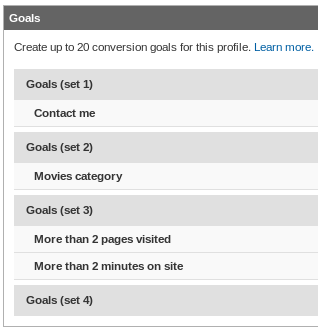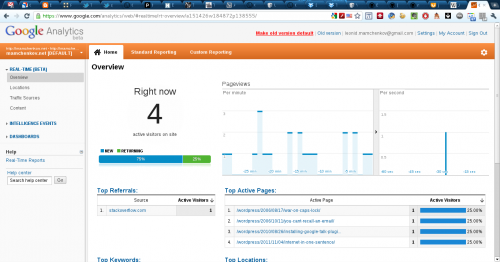Segment.io – common API for web analytic services and applications
Tag: Google Analytics
Google Analytics : Real Time Overview
In the last few month, Google Analytics team haven’t been getting much sleep I guess. They release features upon features upon features. I usually don’t have the time to properly check every feature they do right when they do it, so I keep a browser tab with an announcement open until I get to play with it. Sometimes though, either I lose the tab or close it or lose interest or lose hope that I will ever get to it.
Somehow I managed to miss it completely or forget to play with the Real Time beta functionality of Google Analytics. Today I stumbled upon this feature in my reports and I have to say it’s absolutely awesome. If you can’t find it straight away, switch your Google Analytics interface to the new version, navigate to Home tab at the top, then choose Real Time (beta) in the menu on the left, and click on Overview. If you have any sort of traffic on your site at that moment, you’ll see a screen like this, which will update in real time.
During your regular hours, especially on the small sites, it would probably be too boring to watch. But it can save you a lot of time and pulled out hair during a traffic spike.
If I had a busy website and an office full of people, I’d probably put a big screen or a projection on a wall with full screen page of those stats. How cool would that be!
Urchin – Google Analytics in a box
Google Analytics has proven itself over and over again as an extremely valuable tool for pretty much everyone interested in website statistics. But as awesome as it is, Google Analytics has a number of limitations. These don’t come handy when you need to analyze non-public websites, such as intranets or web-based services behind closed firewalls. Sure, there are plenty of alternatives to Google Analytics that you could go with. But what if you wanted to stick to Google Analytics? I thought you couldn’t (that is without tricks and ugly workarounds). Apparently, I was wrong. You could.
Urchin is a packaged Google Analytics application that you can run on your own servers, under your full control. There are a few features in Urchin that are not in Google Analytics (mostly due to Google Analytics not having access to your server logs). Here are the interesting ones:
- Process historical logs
- Status & error codes reports
- Individual visitor history drilldown
These are things that you don’t probably care too much, if you only have a couple of personal blogs to manage. But if you are a company with a few busy websites and large chunks of your revenues spent on the online advertising, you’d want each and every bit of information, including the above.
One other reason that probably only the enterprises will be interested in Urchin is the price. While Google Analytics comes to everyone for free, you’ll have to pay USD $9,995 (yes, almost ten thousand!) for the Urchin license.
And even though the price is quite prohibitive and will leave most people still using Google Analytics, I think it’s nice to have this option.
Rebuilding mamchenkov.net – Step 2 – Monitoring
The best practices of web design and development suggest that I need to set up some goals and monitoring before I make any changes to the web site. This way, I will be able to track how the changes affect the performance of the web site.
The problem is that right now my web site is not set very well for goals that I want it to achieve. But insufficient monitoring is better than none, so I logged into my Google Analytics account and configured the following goals.

According to my own goals for this web site, as described yesterday, I want to get hired more. The only way to track it now is to see how many people used the Contact me page. I will eventually improve my contact details and contact form to be able to track more details. Once that is done, I’ll reconfigure this goal.
One other thing I want people to do is read more of my movie reviews. Again, there is no easy way of monitoring it now, so I just setup a goal for the Movies category. This will probably get reconfigured later.
And just to have some generic goals for an overall picture, I added tracking for those who visit more than 2 pages and for those who spend more than 2 minutes on the site. That should be enough for starters.
How accurate is Google Analytics?
That’s the question that I was asked recently by one of the co-workers. It is simple and not so simple at the same time. It really depends on what you are looking for, what is the acceptable accuracy, and what is that you are comparing Google Analytics with.
For example, if you compare the numbers from your Google Analytics reports to the summaries of the web server logs, you’ll probably find that Google Analytics reports lower numbers. Almost like not everything is recorded. Which is true because Google Analytics is using JavaScript to track your visitors. Server logs record all hits to your web server, but the information in logs is very limited – it won’t be enough for anything but very basic tracking.
How much will numbers differ? Here is what Google Analytics blog has to say:
Google Analytics uses JavaScript tags to collect data. This industry-standard method yields reliable trends and a high degree of precision, but it’s not perfect. Most of the time, if you are noticing data discrepancies greater than 10%, it’s due to an installation issue. Common problems include JavaScript errors, redirects, untagged pages and slow client-side load times.
Having used Google Analytics on a number of sites over a number of years, I’d say that that is just about right.

